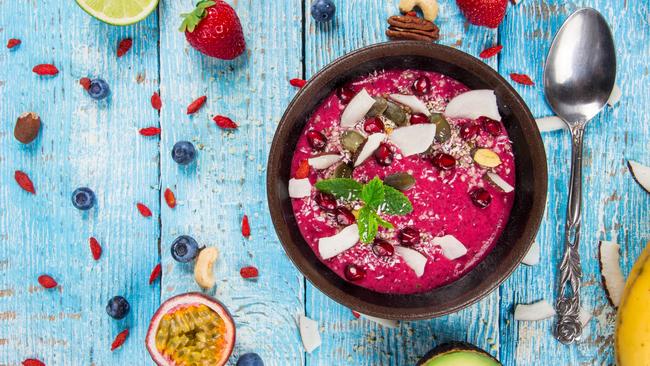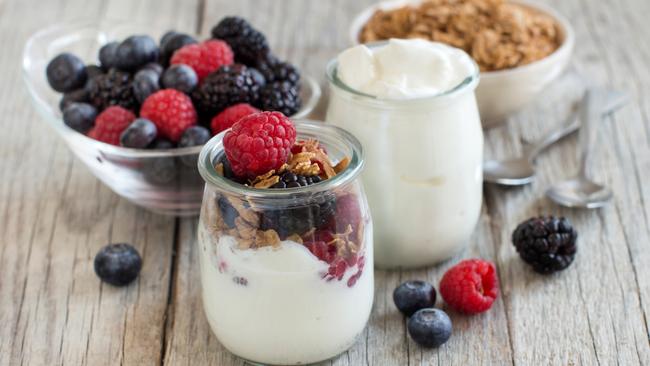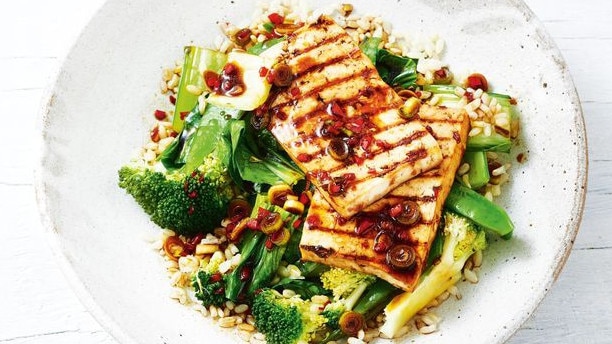Leaner, stronger, fitter: The meal plan
Eating well for a healthy, lean body in the new year does not need to be complicated.

Putting theory into practice is where many diets come unstuck. But the registered nutritionist Rhiannon Lambert, author of The Science of Nutrition, says eating for a healthy, lean body does not need to be complicated.
Aim for three daily meals and stick to timings that suit you. “The focus should be on maintaining consistent eating patterns that align with your energy needs and hunger cues,” Lambert says. “Try to avoid large fluctuations in blood sugar levels by eating balanced meals - a mix of protein, fibre and healthy fats - to support sustainable weight loss.” Each of those meals should include some high-quality protein sources. “Eggs, lean meats, dairy, tofu or legumes with every meal is recommended,” Lambert says, “and spreading protein intake evenly across the day is also beneficial, as the body has a limited ability to utilise protein from a single meal for muscle repair and growth.”
Target fresh fruit, vegetables and wholegrains for the fibre and nutrients needed to support your body through adaptations. “Minimally processed carbs like oats, sweet potatoes and wholegrains help to maintain steady energy levels without causing rapid fluctuations in blood sugar levels, which again can aid in weight management as you will feel fuller for longer,” Lambert says. “Allow yourself a couple of healthy snacks if you need them.
Alcohol should be limited. “A large glass of wine or a pint of lager can contain 200 calories, which adds up quickly,” she says. “Any antioxidants in red wine won’t help with weight loss.”
Research suggests that eating too late in the day could be linked to weight gain, so try to finish your last meal (snacks included) at least three hours before bedtime.

BREAKFAST
Dark berries: packed with vitamin C and disease-fighting antioxidant anthocyanins, they support brain, but and immune health. Serve with yoghurt or oats.
Yoghurt: Greek or plain yoghurt contain beneficial bacteria and good amounts of appetite-suppressing protein. Top with berries or dried fruit and add a teaspoon of honey, which can improve the uptake of the beneficial bacteria by the gut, according to a recent study in The Journal of Nutrition.
Eggs: Rich source of nutrients, and yolks contain protein and other compounds that enhance muscle growth and recovery.
Oats: Whether you serve them as Bircher muesli or as porridge, oats are rich in beta-glucan, a soluble fibre that forms a gel-like substance in the digestive tract to slow down your digestion and fill you up.
Rye bread topped with avocado: Rye bread is high in fibre, B vitamins and rich in lignans, a polyphenol compound that has antioxidant, immune system-supporting benefits. Top it with smashed avocado, which was shown in a study at the University of Illinois to keep gut microbes happy.

LUNCH
Sweet potato with cottage cheese: Serve a baked sweet potato - rich in fibre if you eat the skin, and containing beta-carotene for a healthy immune system and complexion - with two tablespoons of protein-rich cottage cheese, which can help to boost muscle recovery and metabolism.
Oily fish: Fresh or tinned varieties of oily fish - mackerel, salmon, sardines - contain long-chain omega 3 fats, which, according to the NHS, can help to prevent heart disease, as well as protein and, if you eat the soft bones in tinned fish, some calcium. Stir into a tomato-based sauce - tomatoes are a good source of the potent antioxidant lycopene, which has been linked to a reduction of some cancers, cardiovascular disease and neurodegeneration - with a splash of olive oil to enhance the uptake of antioxidants and serve with fibre-rich wholemeal pasta.
Nuts and nut butters: Nut butters, from peanut and hazelnut to cashew and almond, are packed with protein and fibre to fill you up. Spread on apple slices or rye bread for a light lunch, or add to salad dressings - a jar two parts balsamic to one part nut butter and some olive oil - or thin with water, lemon juice and some crushed garlic to drizzle over a plate of lunchtime veggies for added protein.
Mushroom soup: Mushrooms contain soluble fibre, and have been shown to help to reduce appetite when added to soups and stews. A study from the University of Minnesota found that people who ate 425g of white button mushrooms a day for ten days ate less in the hours after eating than others given the same quantity of meat. Wild mushrooms contain more vitamin D, important for teeth and bones, than cultivated varieties grown in the dark, although some cultivated mushrooms are enhanced with the important vitamin.
Hummus with vegetable sticks: Hummus is made from chickpeas and provides plant-based protein, fibre and healthy fats that support a healthy digestive system. Add vegetable crudites to ramp up the fibre and immune-boosting vitamin C intake.

DINNER
Leafy greens: Packed with antioxidants and fibre, and a daily serving provides enough potassium to help reduce high blood pressure. Eat as a salad sprinkled with nuts and seeds or steam spinach with added protein.
Brown rice: Filling and contains more magnesium, potassium, iron and certain B vitamins than white rice.
Tofu: Made from soya milk, it’s a complete protein, and rich in nutrients that have antioxidant and anti-inflammatory effects. Add to a poke bowl of wholewheat noodles or rice.
Pulses: High in fibre - a study showedpeople lost an average of 0.34kg over six weeks by adding one serving of pulses to their daily diet. Pouches of pre-cooked lentils or tinned chickpeas can be stirred into soups or used to replace meat to create protein-rich dishes.
Turkey/chicken: Skinless breasts provide lean protein, and contain the amino acid beta-alanine, which reduces exercise fatigue. Roast or tray-bake with garlic and vegetables.
SNACKS
Nuts: A source of fibre, protein and antioxidants. Have a small handful (about ten nuts) of as many different nut varieties as you can find to stem hunger pangs.
Medjool dates: Shown in studies to boost the microbiome, which helps with healthy weight and to lower cholesterol. Serve them stuffed with walnuts or any type of nut butter for a high-fibre and high-protein snack.
Edamame beans: Protein-rich but also containing plenty of iron and calcium, these super-beans are perfect as a snack on their own but can also be roasted with olive oil and some gut-friendly parmesan, fried in toasted sesame oil and sprinkled with chilli flakes or added to salads and stir fries.
Prune energy balls: Prunes are an underrated health food, but are packed with fibre and high levels of vitamin K, great for building bone and muscle. Researchers at the University of Liverpool found that overweight people who added prunes to their daily diet lost more weight than those who did not eat them. Mix four prunes with a mashed ripe banana and four to five tablespoons of oats and some seeds of your choice, roll into balls and store in the fridge for a nutritious energy-boosting snack.
Milk: Cow’s or plant milks are a mixture of water, carbs, protein and micronutrients and are great for muscle repair and building, and a favourite of athletes. Whizz up a glass of milk with some cocoa, a banana, a tablespoon of nut butter and some cocoa for a filling post-workout snack.
THE TIMES



To join the conversation, please log in. Don't have an account? Register
Join the conversation, you are commenting as Logout